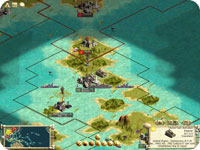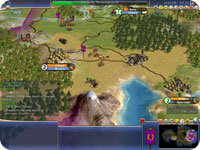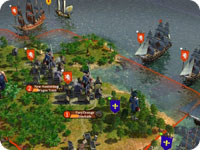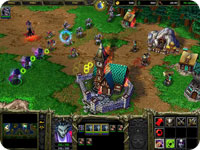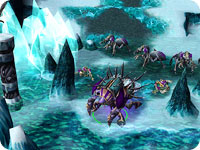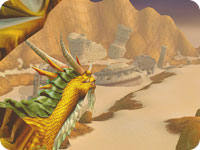Civilization: Empire Building, One Turn at a Time
“You are challenged to build an empire that stands the test of time,” says the manual for the first entry in the Civilization series of games, which debuted in 1991. Legendary developer Sid Meier created the game for MicroProse, the company he co-founded in 1982. As in its sequels, a Civilization session begins with each player in control of a single settler but gradually grows more complex as the participants acquire more territory, develop their technology, and eventually bump into the neighbors. Players do not have to engage in warfare to win the game.
That basic template has served the series well, through Civilization III and its Conquests and Play the World expansion packs, as well as Civilization IV and its Beyond the Sword and Warlords expansion packs. Civilization IV: Colonization is a standalone game that begins in the year 1492 and explores the settling of the New World. However, each edition features tweaks to the gameplay, such as Civilization III’s bargaining table for crafting diplomatic agreements and Civilization IV’s Great People, who confer a variety of powerful bonuses. Civilization IV also guided the series into the realm of 3D graphics.
Civilization the turn-based computer strategy game bears some resemblance to Civilization the board game, which Avalon Hill published in 1981, although Meier has said that he had only passing familiarity with it. While both games emphasized building an empire from nothing and advancing through a technology tree along the way, the board version didn’t progress into the modern age (one way to win the videogame is to build a spaceship and blast off for Alpha Centauri, which is a nod to another Meier game) and featured more linear gameplay.
MicroProse licensed the Civilization from Avalon Hill anyway, just to avoid any future problems. In 1998, both companies were purchased by Hasbro Interactive, which was acquired by Infogrames three years later. Meier, however, had previously parted ways with MicroProse and had co-founded Firaxis Games in 1996. He took the rights to the Civilization series with him; the third and fourth entries were developed by Firaxis.
Prolific designer Will Wright made his mark on the industry with the SimCity series, which challenges players to build and manage their own metropolis. But what if you dropped the macro viewpoint and instead focused on the lives of specific SimCity denizens? That was the inspiration for The Sims, a game that was initially met with skepticism by Electronic Arts executives but which became the top-selling videogame of all time two years after its release in 2000.
Unlike many other games, there is no way to win or lose in the original version of The Sims, aside from seeing your Sims die of starvation due to negligence or watching them perish in an accident. You simply guide your digital creations through their lives, managing their relationships with other Sims and making such choices as which career to undertake or what to do with their idle time. Your Sims spend their hard-earned Simoleons — the Sims’ currency — on stuff for their houses and never grow old and die, although they can produce babies who become children but never turn into adults.
Wright and his development team at Maxis, which is owned by Electronic Arts, produced seven expansion packs for The Sims — Hot Date, House Party, Livin’ Large, Makin’ Magic, Superstar, Unleashed, and Vacation — before turning their attention to The Sims 2, which was released in 2005. The second iteration is fully 3D, allowing you to zoom in and out of the action, and it features digital DNA that your Sims pass on from one generation to the next. Now they progress from baby to toddler to child to teen to young adult (only if you have the University expansion pack) to adult, with expanded versions of the micro-management functions found in the earlier game. Improved artificial intelligence lets you tell your Sims to take care of everyday functions, such as eating and bathing, on their own, so you can worry about their lives’ big pictures. And unlike in the previous game, they pass away from old age, unless a mishap claims them first.
In addition to University, Maxis has produced five other expansion packs: Nightlife, Open For Business, Pets, Seasons, and Bon Voyage. The Family Fun Stuff, Glamour Life Stuff, and Happy Holiday Stuff packs feature new accessories to keep your Sims stimulated and happy, including furniture, clothes, decorations, and more. A few spin-offs, The Sims Life Stories, The Sims Pet Stories, and The Sims Castaway Stories use the well-known Sims gameplay to focus on the trials and tribulations of specific characters.
Over the years, the Sims have also appeared on various videogame consoles, such as GameCube, Xbox, Nintendo DS, and Sony PSP. The Sims 3 expands the franchise with a host of new features, including: open-ended neighborhoods that end the need to load new locations; nearly limitless customization options for not just your Sims but also everything in their environment; new ways for your Sims to pursue their dreams; more methods for connecting with other Sims players online; and more. The Sims 3: World Adventures expansion pack lets your Sims travel to Egypt, China, and France and explore ancient tombs, learn martial arts, develop their photography skills, and more. The Sims 3: Ambitions and The Sims 3: Fast Lane Stuff have also recently been released.
The Sims are also expected to bring their complicated relationship dynamics to the silver screen someday, although film rights owner 20th Century Fox hasn’t revealed any details. Meanwhile, Will Wright turned his attention from terrestrial affairs to galactic ones with SPORE, which challenges you to evolve a species from simple organism to space-faring empire. No need to tell them to clean a toilet. An expansion pack focusing on galactic conquest is on the way.
Like many of today’s top-flight game developers, Blizzard Entertainment rose from modest beginnings. In this case, the company — known originally as Silicon & Synapse — launched in 1991 with the intent of porting games from one platform to another. Two years later, they jumped into original development with such titles as The Lost Viking, whose characters have made cameos in many later Blizzard games, including World of Warcraft.
In 1994, Silicon & Synapse became Blizzard Entertainment and launched Warcraft: Orcs & Humans for Windows and Mac. While the game wasn’t the first real-time strategy (RTS) title in existence, it helped popularize the genre, becoming a best-seller that set the stage for 1995’s sequel, Warcraft II: Tides of Darkness, along with a 1996 expansion pack called Beyond the Dark Portal.
While fans clamored for more RTS excitement set in the world of Azeroth, Blizzard made a move that has become typical for the company: leaving gamers hungry for more while launching a new franchise. In this case, Blizzard took a break from Warcraft to release the role-playing adventure Diablo in 1996 and the science-fiction RTS game Starcraft in 1998, two series that have also become fan favorites. A month after Diablo’s introduction, Blizzard rolled out Battle.net, an online service for players of its games to engage in head-to-head competition.
1998’s Brood War expansion pack for Starcraft took the battle between the Terrans, Protoss, and Zerg in new directions, while 2000’s Diablo II places you in the boots of a new hero determined to put an end to The Lord of Terror’s reign. In 2001, the Lord of Destruction expansion pack capped the Diablo II story, but the tale isn’t over: Diablo III will take you back to that hellish realm. A Starcraft sequel is currently in the works.
Back to the Well
Meanwhile, Blizzard turned its attention back to Warcraft for the third installment in the series, known as Reign of Chaos, which was released with great fanfare in 2002. An expansion pack, The Frozen Throne, followed in 2003, and the following year, Blizzard achieved its biggest success to date when it took the Warcraft series into the realm of massively multiplayer online role-playing games with World of Warcraft. The company released frequent updates to the game, culminating in the publication of The Burning Crusade expansion pack in 2007. Another expansion, Wrath of the Lich King, took players to a frigid new land called Northrend in 2008. Big changes are in store in the upcoming Cataclysm expansion pack, which will forever alter well-known areas of Azeroth as the dragon Deathwing the Destroyer literally erupts from his underground slumber. New features include a pair of new races — Goblins and Worgen — and more.
Along the way, Blizzard has allowed others to continue its franchises’ stories by licensing the publication of novels based on the Warcraft, Diablo, and Starcraft universes. You can also play Warcraft as a pen-and-paper role-playing game, similar to the granddaddy of that genre, Dungeons & Dragons, or experience its stories in a new medium through a 12-issue comic book series published by DC Comics.
And with movies based on World of Warcraft and Diablo in the planning stages, Blizzard clearly has no plans to stop conquering new territory.

